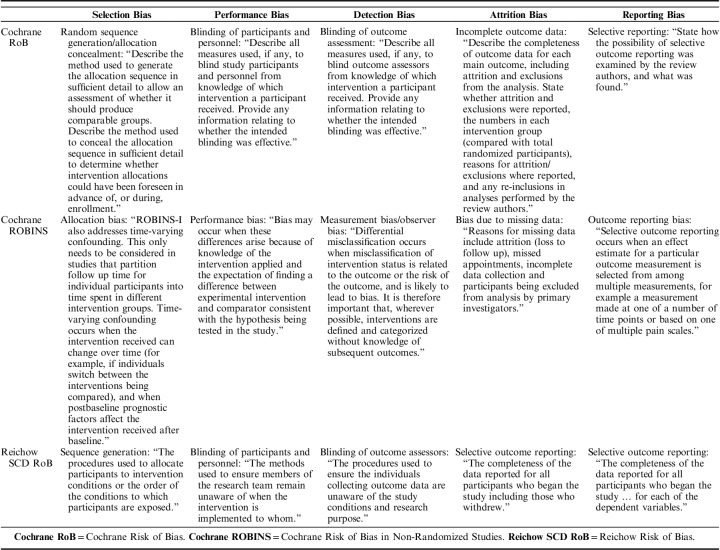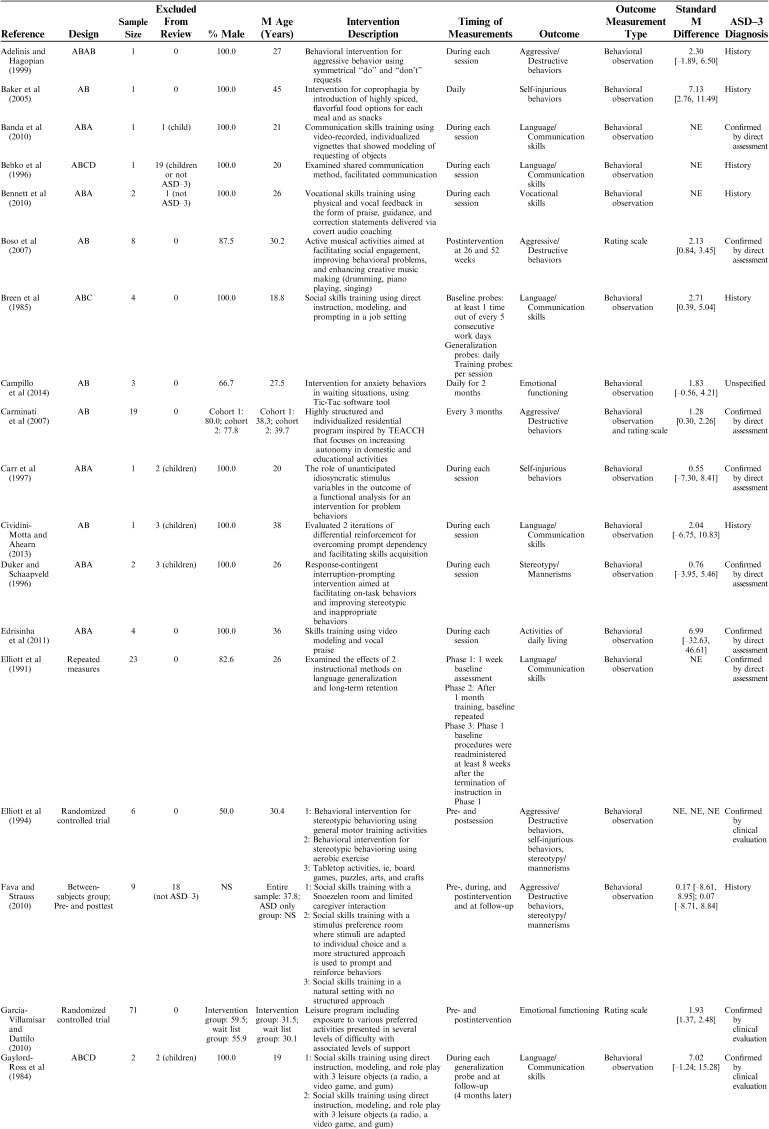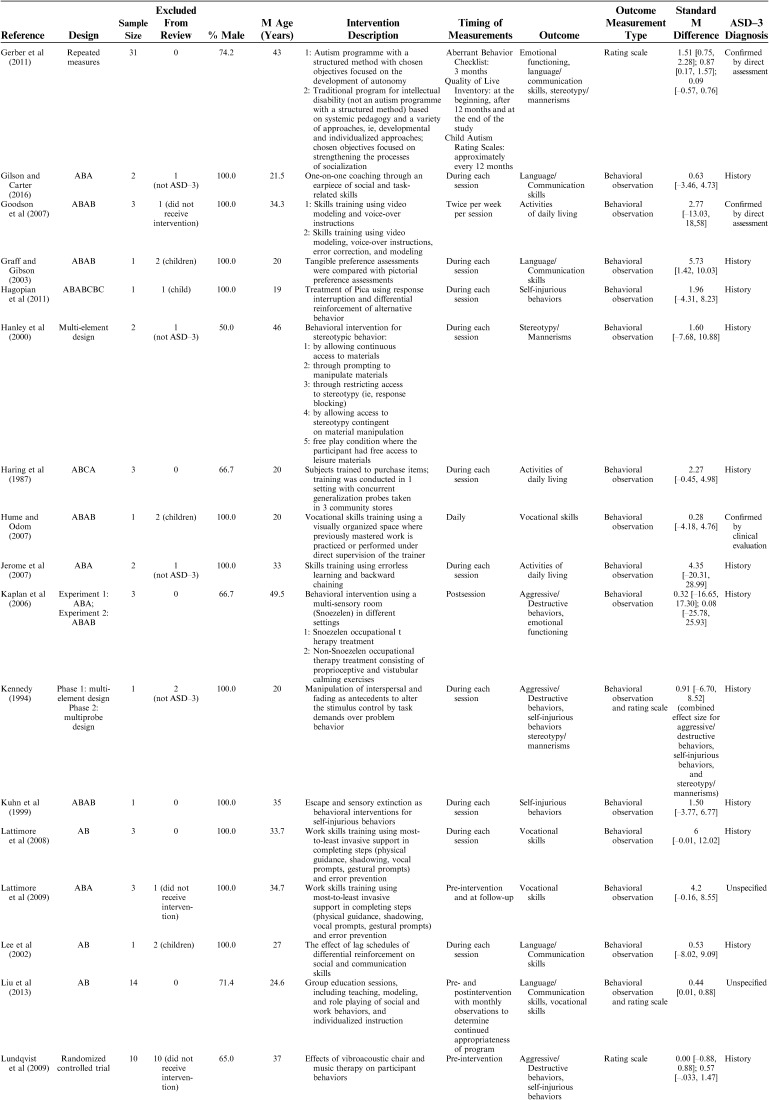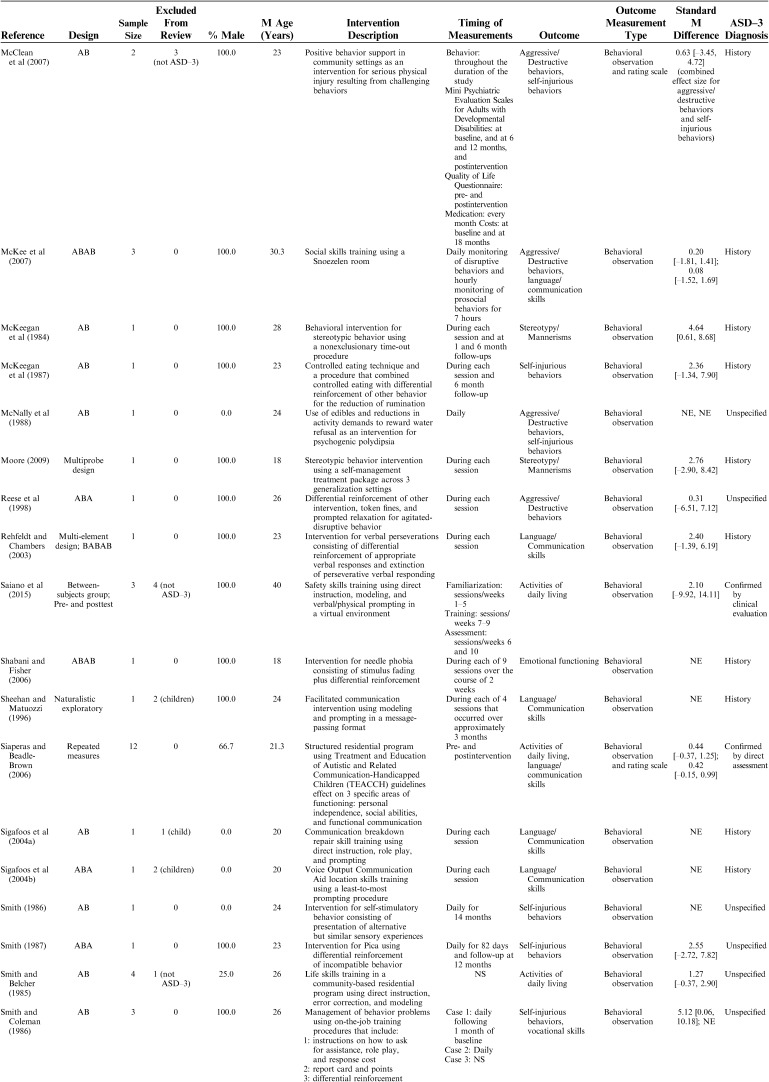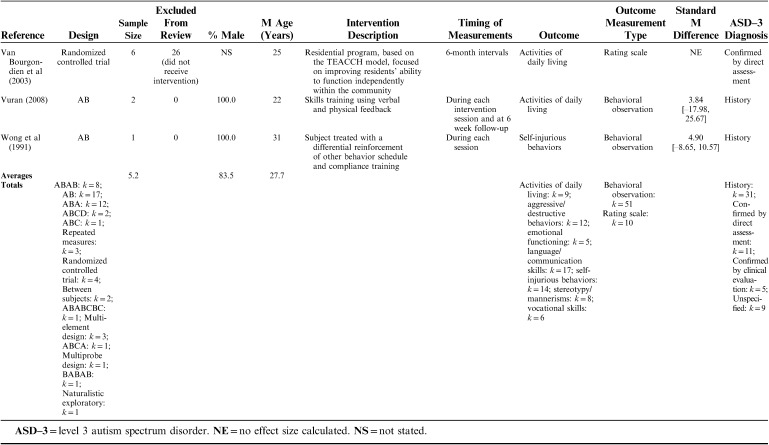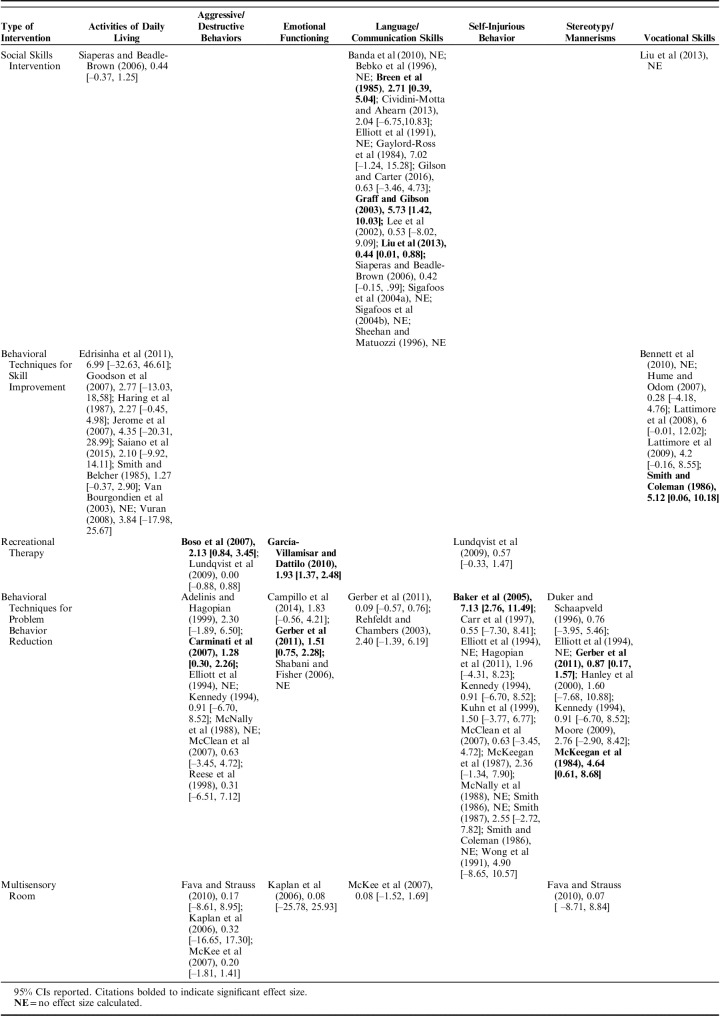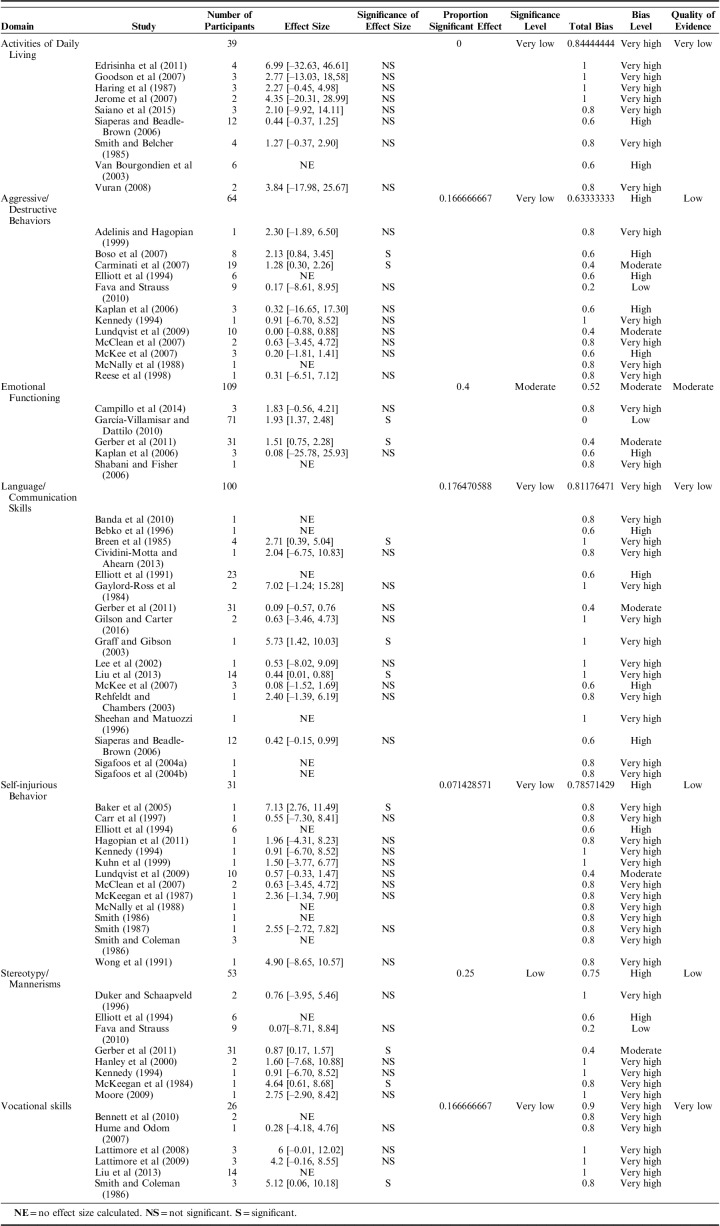Abstract
There is face validity to the expectation that adults with level 3 autism spectrum disorder (ASD–3) will benefit from a range of psychoeducational interventions. This paper reviews the empirical evidence supporting the effectiveness of these interventions, many of which are currently used in clinical settings. We reviewed 56 peer-reviewed studies of psychoeducational interventions for adults with ASD–3, written in English and since 1968, that met our criteria. The reviewing team included educators, clinicians, researchers, and a biostatistician. The available literature was limited, and most, if not all, of the studies presented some significant methodological limitations. When using Cochrane’s criteria to assess seven key outcome domains—activities of daily living, aggressive/destructive behaviors, emotional functioning, language/communication skills, self-injurious behaviors, stereotypy/mannerisms, and vocational skills—we found only moderately reliable evidence to support the effectiveness of interventions designed to improve emotional functioning in adults with ASD–3. The reliability of evidence relevant to the six other outcome domains was rated as low or very low. Based on this review, we suggest directions for future study of interventions for adults with ASD–3, including topics, subpopulations, and approaches that should be explored. We also propose some crucial changes in how future studies regarding this population should be designed, analyzed, and documented, while balancing clinical considerations with scientific/educational utility.
Key Words: autism, psychoeducational intervention, applied behavioral analysis, behavioral training
- ASD
autism spectrum disorder
- ASD–3
level 3 autism spectrum disorder
It is generally assumed that children with autism spectrum disorder (ASD) may benefit from a variety of psychoeducational interventions (ie, nonmedical interventions that attempt to modify behavior), just as such interventions have long been assumed to benefit typically developing children. This assumption has helped guide legislation in many countries. In the United States, for example, children with ASD are entitled by federal law to a free specialized public education, which may include services such as speech therapy, occupational therapy, vocational training, and behavioral support (Individuals with Disabilities Education Act, 2004).
However, even in the United States, government support for education and other training services for individuals with autism (and those with other disabilities) typically ends by age 21 at the latest, which is problematic. It is clear that the need and capacity for learning new skills in typically developing individuals continue throughout adulthood and well into old age (Stoner et al, 2006). There are reasons to believe this is also true (if not more true) for individuals with developmental disabilities such as ASD (Howard-Jones, 2014). Because many 21-year olds with ASD can expect to have three quarters or more of their lives ahead of them, it can hardly be expected that their learning requirements will end at age 21; however, persisting inequality in access to educational opportunities poses the risk that the learning capacities of adults with ASD remain untapped.
This lack of psychoeducational and other services for adults with ASD is particularly problematic for adults with level 3 ASD, referred to as ASD–3. ASD–3 is defined by the most recent version of the Diagnostic and Statistical Manual of Mental Disorders (DSM–5; American Psychiatric Association, 2013) as “requiring very substantial support” due to severe impairments in social communication and restrictive/repetitive behaviors. Although the scale of severity described in the Diagnostic and Statistical Manual is defined by key functional impairments such as poor social communication and restricted/repetitive behaviors, it is important to consider a potential heterogeneous set of comorbid impairments, including intellectual disability and behavioral impairments, that could also require substantial support. Interventions aimed at reducing the impact of these impairments and facilitating individuals with ASD in practicing self-care, employment, and participation in recreational activities would arguably significantly improve their quality of life and also help reduce the enormous cost of social care (Leigh and Du, 2015).
To our knowledge, no prior reviews have investigated the availability and quality of psychoeducational interventions for adults with ASD–3. The only reviews we located focused on psychoeducational interventions for adults with mixed- and/or higher level ASD, and these supported the effectiveness of applied behavioral analysis (Aylott, 2000), social skills interventions (Aylott, 2000; Lorenc et al, 2018; Reichow and Volkmar, 2010), vocational skills interventions (Lorenc et al, 2018; Nicholas et al, 2015), and video modeling interventions (Reichow and Volkmar, 2010). One prior review of psychoeducational interventions for mixed-age individuals with ASD–3 also supported the effectiveness of social skills interventions using video-based, developmental, peer-mediated, behavioral, and structured teaching approaches (Walton and Ingersoll, 2013). Several other published reviews of interventions for children and mixed-aged individuals with ASD notably highlighted the lack of research into interventions for adults with ASD–3 and called for more attention to the topic (Kasari et al, 2014; Lorenc et al, 2018; Matson, 1996; Shattuck et al, 2012; Taylor et al, 2012; Weiss and Harris, 2001).
OBJECTIVE
We conducted this review in order to clarify what psychoeducational interventions have been shown to work best for what behavioral outcomes within the ASD–3 category. At present, behavioral training methods that have proven effective in the treatment of behavioral deficits in children with ASD (Heflin and Simpson, 1998) have been widely adopted and adapted for adults with ASD. Nonetheless, there are considerable controversies as to the suitability of these methodological adaptations for adults with ASD–3, as well as to what knowledge or skills should be taught (Heflin and Simpson, 1998). For instance, given the inevitable limitations in time and resources facing clinicians and educators, what skills and competencies should be psychoeducationally targeted and how? Should we try to improve independent self-care skills, social skills, and/or work-related competencies? Should we focus instruction on improving skills that are deficient, enhancing best individual abilities, or developing compensatory mechanisms? These same questions have concerned educators and psychologists studying the ASD–3 population for decades, as have the best potential psychoeducational strategies.
The main aims of this review were to (a) assess the psychoeducational interventions that have thus far been applied to adults with ASD–3, (b) identify how rigorously these interventions have been applied and assessed (eg, adherence to protocols, data collection, and analyses) using quality assessment/risk of bias tools, (c) evaluate the efficacy of the interventions used so far within the adult ASD–3 population, and (d) suggest practical ways to advance the field of psychoeducational interventions.
METHODS
Search and Information Sources
We searched articles and reports within the 50-year period from 1968, when applied behavioral analysis first appeared in the literature (Baer et al, 1968), to the present. Our inclusion criteria were adults (age ≥18 years) with a primary diagnosis of ASD at level 3 on the severity scale (“requiring very substantial support”; American Psychiatric Association, 2013).
We started with relatively broad searches of the PubMed and Google Scholar electronic databases, using the search terms (“1968”[PDAT]: “3000”[PDAT]) AND (“autism”[All Fields] OR “autistic”[All Fields] OR “ASD”[All Fields] OR “PDD”[All Fields]) AND “adult”[All Fields] AND (“intervention”[All Fields] OR “treatment”[All Fields] OR “therapy”[All Fields] OR “training”[All Fields]). We used broad search terms because recent debates regarding the suitability of specific terminology to describe severity level (eg, low-functioning, Asperger’s) made it difficult to synthesize search terms that would extract our specific target population. Also, we wanted to evaluate the far-reaching conclusions and impacts of a wide range of interventions.
Because our review was limited to studies on psychoeducational interventions, we did not include literature reviews, meta-analyses, books, or program reports (see Eligibility Criteria and Study Selection), although several were identified in the electronic search. However, we did manually scrutinize the reference lists of literature reviews and meta-analyses (Aylott, 2000; Bishop-Fitzpatrick et al, 2013; Broadstock et al, 2007; Brugha et al, 2015; Committee on Children With Disabilities, 1998; DeJong et al, 2014; El Achkar and Spence, 2015; Gates et al, 2017; Kasari et al, 2014; Lorenc et al, 2018; Matson et al, 2011, 2016; Millar et al, 2006; Nicholas et al, 2015; Ratto and Mesibov, 2015; Reichow and Volkmar, 2010; Reichow et al, 2013; Rutter, 1996; Schreibman, 1996; Shattuck et al, 2012; Sinha et al, 2004, 2006; Sturmey, 2012; Taylor et al, 2012; Tsai, 1999; Vismara and Rogers, 2010; Volkmar et al, 1999, 2014; Walton and Ingersoll, 2013; Weiss and Harris, 2001; Wong et al, 2015), books (Sheridan and Raffield, 2008; Volkmar et al, 2014), and program reports (Young et al, 2010) in order to identify relevant studies that did not appear in the electronic search.
Eligibility Criteria and Study Selection
After completing the literature search, we screened abstracts and full texts of all identified studies to determine which to include in our review. Two eligibility reviewers (K.S.D. and S.A.K.) screened the studies to make sure they met our inclusionary criteria and then rated the articles on a dichotomous scale (ie, include or exclude); any differences in global eligibility ratings were arbitrated by a third reviewer (A.D.).
We included studies based on the following criteria:
-
Types of participants
◦ Participants had to be adults (ie, ≥18 years).
◦ Participants had to be diagnosed with ASD–3, as retroactively determined (if necessary) from the information available in the paper. If the ASD severity level was not explicitly stated, level 3 was assumed if the participants had any intellectual disability, language deficits, or poor activities of daily living; were in a residential treatment setting; and/or presented with highly frequent stereotyped/repetitive behaviors.
-
Types of interventions
◦ The study included participants who took part in a psychoeducational intervention.
-
Types of studies
◦ Quantitative pre-intervention data were reported either in the published article or in freely available supplemental information.
◦ Quantitative postintervention data were reported either in the published article or in freely available supplemental information.
◦ The published study had to be available on an electronic database and written in English.
We excluded studies based on the following criteria:
-
Types of participants
◦ Participants were children and/or adolescents (ie, aged <18 years).
◦Participants were not adults with ASD (eg, participants were either children of, or family members and caregivers of, individuals with ASD).
◦ ASD severity was below level 3 (ie, the severity level was determined to be level 1 or 2, or the level could not be determined from the available data).
-
Types of interventions
◦ The study was not a true intervention study (ie, it was a systematic review, meta-analysis, prevalence study, description of symptoms, follow-up study), and/or it was another type of nonempirical study (eg, position paper, book review).
◦ The study consisted of pharmacological or other “physical” intervention methods.
-
Types of studies
◦ Quantitative data relevant to the psychoeducational intervention, either pre, post, or both, were not reported in the article nor in freely available supplemental information.
◦ The published study was not available in English.
Regarding terminology, we use the term “psychoeducational” in this review as an umbrella term for all efforts attempting to modify behaviors via nonmedical approaches. We interpreted psychoeducational broadly and inclusively. We included, but did not limit our consideration to, practical applications of applied behavioral analysis as well as methods that may have been given more specific names, such as “discrete trial training”; “developmental, individual-differences, relationship-based floortime”; “pivotal response analysis”; “verbal behavior therapy”; “early start Denver model”; “relationship development intervention”; “milieu teaching”; and “social communication/emotional regulation/transactional support.” Our use of the term psychoeducational specifically excludes methods that involve pharmacological agents, electrical brain stimulation, or any other methods that would traditionally be considered “physical” interventions.
Data Collection and Analysis
Data Extraction and Management
Information was extracted by K.S.D. and was checked by S.A.K. for sampling, recruitment, types of intervention, methods of data collection and analysis, and results (Higgins and Green, 2011). S.A.K. attempted to follow-up with the corresponding authors of the identified studies to obtain missing information. We received responses from only some of these authors, but we included what data we could extract from all of the articles included in our review so as not to risk bias.
Risk of Bias Within Studies
We assessed each identified study for quality and for risk of bias using standards outlined in the Cochrane Risk of Bias data extraction template for randomized interventions (Higgins and Green, 2011), the Cochrane Risk of Bias in Non-Randomized Studies template for nonrandomized interventions (Sterne et al, 2016), and the Reichow Risk of Bias template for case studies (Reichow et al, 2018). Because bias domains in the Cochrane Risk of Bias, Cochrane Risk of Bias in Non-Randomized Studies, and Reichow Risk of Bias tools overlap, we mapped bias domains from the Cochrane Risk of Bias in Non-Randomized Studies and the Reichow Risk of Bias onto the original scoring conventions of the Cochrane Risk of Bias. We identified five key bias domains (selection bias, performance bias, detection bias, attrition bias, and reporting bias) and design-specific criteria for each domain (Table 1). We assessed each bias domain as being low risk, moderate risk, high risk, or very high risk. Quality assessment was carried out independently by S.A.K., A.D., and K.S.D., and any differences in opinion were arbitrated by R.L.S.
TABLE 1.
Bias Domain Definitions
Summary Measures
In order to derive treatment effect sizes, we calculated standardized mean difference scores and 95% CIs using pre- and postintervention scores of the primary outcome variables for each study (Higgins and Green, 2011; Olive and Smith, 2005). Several of the studies from our electronic and hand searches included some participants who were not diagnosed with ASD–3; for those studies, we considered only the findings for the participants with ASD–3.
Synthesis of Results
Inconsistencies and variability in reporting of intervention content and outcome measures made a structured meta-analysis impossible. Thus, we organized our synthesized results according to behavioral outcome.
Risk of Bias Across Studies
In order to rate the certainty of evidence supporting psychoeducational interventions targeting specific behavioral outcomes, we used the Cochrane GRADE approach to rate the literature, taking into account the quality of the evidence and the magnitude of the effect (Schünemann et al, 2013).
RESULTS
Study Selection
Our electronic search yielded 4357 studies across PubMed and Google Scholar (PubMed k=4348, Google Scholar k=9, no duplicates); our hand search yielded 24 studies. Figure 1 is a flow diagram of our literature search.
FIGURE 1.
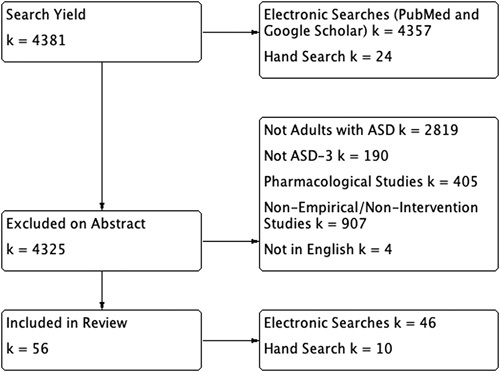
Flow diagram of our literature search. ASD–3=level 3 autism spectrum disorder.
We excluded studies for the following reasons: they were intervention studies in which participants were not adults with ASD (ie, children and/or adolescents with ASD or family members of individuals with ASD, k=2819); they were intervention studies in which participants did not meet the criteria for ASD–3 or it was impossible to isolate the results for participants with ASD–3 (k=190); they were studies of pharmacological interventions (k=405); they were nonempirical studies or quantitative data relevant to the psychoeducational intervention were not provided (k=907); or the study was not available in English (k=4).
Ultimately, a total of 56 studies were included in this review: 46 (82%) from the electronic search and 10 (18%) from the hand search. Of the studies identified by electronic search, 16 were published in the last 10 years, and 40 were published earlier; of the studies identified by hand search, one was published in the last 10 years, and nine were published earlier. The 56 studies that ultimately met our criteria for inclusion in this review are summarized in Table 2.
TABLE 2.
Characteristics of Included Studies
TABLE 2.
(continued)
TABLE 2.
(continued)
TABLE 2.
(continued)
Risk of Bias Within Studies
Given the difficulties in studying the ASD population, as well as the evolution of research standards over the last 50 years, we (as expected) found many methodological limitations in all of the studies. Considering current terminology, these limitations raise the possibility of biases in the interpretation of the data. Because they were common between studies, the limitations will be reported as general themes rather than discussing them study by study. Figures 2 and 3 depict our bias assessments.
FIGURE 2.
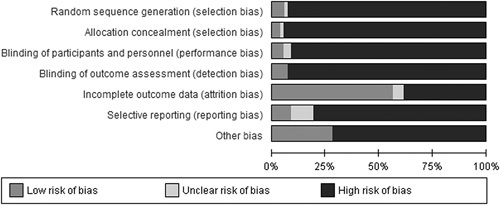
Risk of bias graph: Review authors’ judgments about each risk-of-bias item presented as percentages across the 56 studies.
FIGURE 3.

Risk of bias summary: Review authors’ judgments about each risk-of-bias item for each included study. +=high risk. −=low risk. ?=unclear risk.
There was a high risk of bias in terms of the study design of the studies we included in our review (Higgins and Green, 2011; Reichow et al, 2018; Sterne et al, 2016). First, only a few of the studies were randomized controlled trials; this, by default, introduces selection bias to the sampling strategy. In most of the studies, the participants were selected based on the subjective judgment of the clinicians. It is important to note that it is extremely difficult to conduct randomized controlled trials on this population given that few institutions provide regular access to participants. Other ethical and logistical considerations associated with this population—including, but not limited to, obtaining consent for participation, transportation to and from sessions, and compensation for participation—make this population relatively challenging to recruit. Nevertheless, we did identify four randomized controlled trials containing both a treatment group and a control group (Elliott et al, 1994; García-Villamisar and Dattilo, 2010; Lundqvist et al, 2009; Van Bourgondien et al, 2003). However, the process of randomization was clearly described in only three of these (Elliott et al, 1994; Lundqvist et al, 2009; Van Bourgondien et al, 2003), and all four studies provided inadequate descriptions of the inclusion and exclusion criteria as well as limited information on other potential neurodevelopmental factors that may have influenced participant performance. Thus, it is difficult to tell how representative the participants in the four studies were of the population as a whole (which, as mentioned, is heterogeneous in itself). Moreover, it was impossible to determine the presence of any confounding factors relevant to the outcomes tested. Only three of the 56 studies (Carminati et al, 2007; Fava and Strauss, 2010; Gerber et al, 2011) blinded the participants, investigators, and outcome assessments; the remainder of the included studies did not consider the impact of performance and detection bias in their designs.
We also found that the assessment of interrater reliability was often insufficient, which is of particular concern for studies of psychosocial and behavioral functioning, in which assessment of the outcome is subjective. Missing data were also encountered in many of the studies in our review; however, few of the studies discussed this issue, and there are no available published analyses of the possible patterns of missing data that may have confounded the reported findings and their interpretation.
To assess whether the methodological quality of the studies improved over time, we correlated the number of methodological issues identified with the publication date of each study. The quality of study methods did show a trend toward improvement with time, but this trend was not significant (r=–0.211, P=0.110; Figure 4).
FIGURE 4.
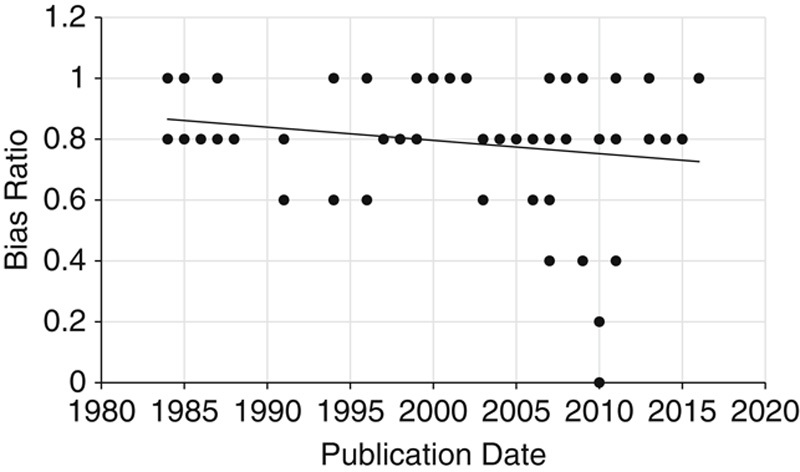
Bias ratio by publication date: Ratio of bias domains judged to have high risk plotted against publication date.
Descriptive Review of the Findings
Despite the aforementioned issues, the studies we reviewed did provide useful evidence concerning psychoeducational interventions for adults with ASD–3. This evidence will be qualitatively evaluated here by behavioral outcome (see Tables 3 and 4, and Figure 5, for a complete summary of the data).
TABLE 3.
Effectiveness of Interventions for Each Behavioral Outcome
TABLE 4.
Cochrane Grades of Recommendation, Assessment, Development and Evaluation (GRADE) Working Group Evaluation
FIGURE 5.
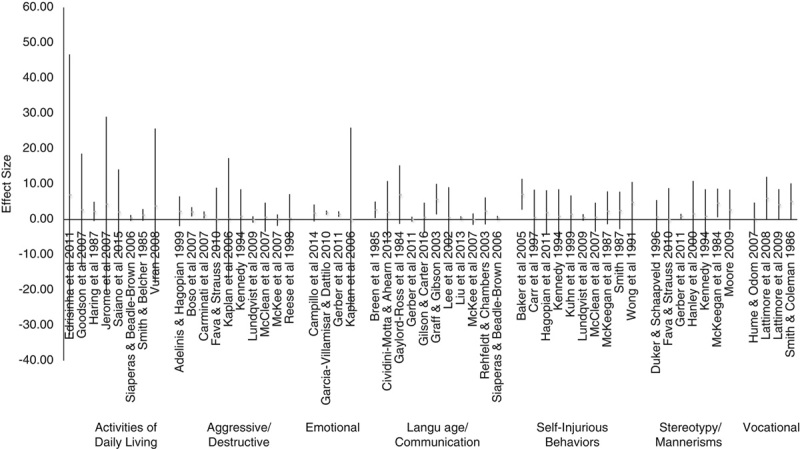
Forest plot of comparison: Pre- versus postintervention scores, effect sizes (ie, standardized mean differences).
Activities of Daily Living
Due to a very low proportion of studies that showed a significant effect of the intervention yet showed a very high risk of bias, the quality of the evidence supporting the effectiveness of interventions to improve daily activities in adults with ASD–3 was very low. This behavioral outcome was investigated in nine studies: Edrisinha et al (2011), Goodson et al (2007), Haring et al (1987), Jerome et al (2007), Saiano et al (2015), Siaperas and Beadle-Brown (2006), Smith and Belcher (1985), Van Bourgondien et al (2003), and Vuran (2008). One study involved a social skills training program as the intervention (Siaperas and Beadle-Brown, 2006); the other eight studies focused on behavioral techniques as the intervention (Edrisinha et al, 2011; Goodson et al, 2007; Haring et al, 1987; Jerome et al, 2007; Saiano et al, 2015; Smith and Belcher, 1985; Van Bourgondien et al, 2003; Vuran, 2008). Of the seven studies for which we could calculate an effect size, none showed a significant effect.
Aggressive/Destructive Behaviors
Due to a very low proportion of studies that showed a significant effect of the intervention yet showed a high risk of bias, the quality of the evidence supporting the effectiveness of interventions to reduce aggressive/destructive behaviors in adults with ASD–3 was low. This outcome was investigated in 12 studies: Adelinis and Hagopian (1999), Boso et al (2007), Carminati et al (2007), Elliott et al (1994), Fava and Strauss (2010), Kaplan et al (2006), Kennedy (1994), Lundqvist et al (2009), McClean et al (2007), McKee et al (2007), McNally et al (1988), and Reese et al (1998). Two studies used recreational therapies as the intervention (Boso et al, 2007; Lundqvist et al, 2009), seven used behavioral techniques (Adelinis and Hagopian, 1999; Carminati et al, 2007; Elliott et al, 1994; Kennedy, 1994; McClean et al, 2007; McNally et al, 1988; Reese et al, 1998), and three used multisensory rooms (Fava and Strauss, 2010; Kaplan et al, 2006; McKee et al, 2007). Of the 10 studies for which we could calculate an effect size, two showed a significant positive effect (Boso et al, 2007: 2.13 [0.84, 3.45]; Carminati et al, 2007: 1.28 [0.30, 2.26]). Boso et al (2007) included active musical activities (ie, drumming, piano playing, singing) for a predominantly male (87.5% male) group of eight adults (M age=30.2); Carminati et al (2007) included a structured applied behavioral analysis approach to a residential program for a predominantly male (78.9% male) group of 19 adults (M age=39).
Emotional Functioning
Due to a moderate proportion of studies that showed a significant effect of the intervention yet showed a moderate risk of bias, the quality of the evidence supporting the effectiveness of interventions to improve emotional functioning in adults with ASD–3 was moderate. This outcome was investigated in five studies: Campillo et al (2014), García-Villamisar and Dattilo (2010), Gerber et al (2011), Kaplan et al (2006), and Shabani and Fisher (2006). One study used recreational therapies as the intervention (García-Villamisar and Dattilo, 2010), three used behavioral techniques (Campillo et al, 2014; Gerber et al, 2011; Shabani and Fisher, 2006), and one used a multisensory room (Kaplan et al, 2006). Of the two studies for which we could calculate an effect size, both showed a significant positive effect (García-Villamisar and Dattilo, 2010: 1.93 [1.37, 2.48]; Gerber et al, 2011: 1.51 [0.75, 2.28]). García-Villamisar and Dattilo (2010) included leisure activities for a mixed-gender (59.5% male) group of 71 adults (M age=31.49); Gerber et al (2011) included a structured behavioral program (physical agent modalities) that focused on the development of autonomy in a mixed-gender (74.1% male) group of 31 adults (M age=43).
Language/Communication Skills
Due to a very low proportion of studies that showed a significant effect of the intervention yet showed a very high risk of bias, the quality of evidence supporting the effectiveness of interventions to improve language and communication skills in adults with ASD–3 was very low. This outcome was investigated in 17 studies: Banda et al (2010), Bebko et al (1996), Breen et al (1985), Cividini-Motta and Ahearn (2013), Elliott et al (1991), Gaylord-Ross et al (1984), Gerber et al (2011), Gilson and Carter (2016), Graff and Gibson (2003), Lee et al (2002), Liu et al (2013), McKee et al (2007), Rehfeldt and Chambers (2003), Sheehan and Matuozzi (1996), Siaperas and Beadle-Brown (2006), and Sigafoos et al (2004a, 2004b). Fourteen of the studies included behavioral programs designed to improve social skills as the intervention (Banda et al, 2010; Bebko et al, 1996; Breen et al, 1985; Cividini-Motta and Ahearn, 2013; Elliott et al, 1991; Gaylord-Ross et al, 1984; Gilson and Carter, 2016; Graff and Gibson, 2003; Lee et al, 2002; Liu et al, 2013; Sheehan and Matuozzi, 1996; Siaperas and Beadle-Brown, 2006; Sigafoos et al, 2004a, 2004b), two included behavioral techniques (Gerber et al, 2011; Rehfeldt and Chambers, 2003), and one included a multisensory room (McKee et al, 2007). Of the 10 interventions for which we could calculate an effect size, three showed a significant positive effect (Breen et al, 1985: 2.71 [0.39, 5.04]; Graff and Gibson, 2003: 5.73 [1.42, 10.03]; Liu et al, 2013: 0.44 [0.01, 0.88]). Graff and Gibson (2003) used preference assessments to increase requesting behaviors for one 20-year-old man; Liu et al (2013) included teaching, modeling, and role playing of social behaviors for a mixed-gender (71.4%) social skills group of 14 adults (M age=24.6); and Breen et al (1985) included a social skills training program for four men (M age=18.75) that included direct instruction, modeling, and prompting in a job setting. All 17 of the interventions involved behavioral techniques (ie, directness, instruction, modeling, and prompting), but none were explicit as to whether they were practical applications of applied behavioral analysis.
Self-injurious Behaviors
Due to a very low proportion of studies that showed a significant effect of the intervention yet showed a high risk of bias, the quality of evidence supporting the effectiveness of interventions to reduce self-injurious behaviors in adults with ASD–3 was low. This outcome was investigated in 14 studies: Baker et al (2005), Carr et al (1997), Elliott et al (1994), Hagopian et al (2011), Kennedy (1994), Kuhn et al (1999), Lundqvist et al (2009), McClean et al (2007), McKeegan et al (1987), McNally et al (1988), Smith (1986, 1987), Smith and Coleman (1986), and Wong et al (1991). One study used recreational therapies as the intervention (Lundqvist et al, 2009), and 13 used behavioral techniques (Baker et al, 2005; Carr et al, 1997; Elliott et al, 1994; Hagopian et al, 2011; Kennedy, 1994; Kuhn et al, 1999; McClean et al, 2007; McKeegan et al, 1987; McNally et al, 1988; Smith 1986, 1987; Smith and Coleman, 1986; Wong et al, 1991). Of the 10 studies for which we could calculate an effect size, one showed a significant positive effect: Baker et al, 2005: 7.13 [2.76, 11.49]. Baker et al (2005) reduced coprophagia in one 45-year-old man by introducing flavorful meal options.
Stereotypy/Mannerisms
Due to a low proportion of studies that showed a significant effect of the intervention yet showed a high risk of bias, the quality of evidence supporting the effectiveness of interventions to reduce stereotypy/mannerisms in adults with ASD–3 was low. This outcome was investigated in eight studies: Duker and Schaapveld (1996), Elliott et al (1994), Fava and Strauss (2010), Gerber et al (2011), Hanley et al (2000), Kennedy (1994), McKeegan et al (1984), and Moore (2009). Seven studies used behavioral techniques as the intervention (Duker and Schaapveld, 1996; Elliott et al, 1994; Gerber et al, 2011; Hanley et al, 2000; Kennedy, 1994; McKeegan et al, 1984; Moore, 2009), and one used a multisensory room (Fava and Strauss, 2010). Of the seven studies for which we could calculate an effect size, two showed a significant positive effect (Gerber et al, 2011: 0.87 [0.17, 1.57]; McKeegan et al, 1984: 4.64 [0.61, 8.68]). Gerber et al (2011) was a structured behavioral program (autism program with a structured method) that focused on the development of autonomy in a mixed-gender (74.1% male) group of 31 adults (M age=43 years), and McKeegan et al (1984) used a nonexclusionary time-out procedure on one 28-year-old man.
Vocational Skills
Due to a very low proportion of studies that showed a significant effect of the intervention yet showed a very high risk of bias, the quality of evidence supporting the effectiveness of interventions to improve vocational skills in adults with ASD–3 was very low. This outcome was investigated in six studies: Bennett et al (2010), Hume and Odom (2007), Lattimore et al (2008, 2009), Liu et al (2013), and Smith and Coleman (1986). One of the studies used a social skills program as the intervention (Liu et al, 2013), and five used behavioral techniques (Bennett et al, 2010; Hume and Odom, 2007; Lattimore et al, 2008, 2009; Smith and Coleman, 1986). Of the four studies for which we could calculate an effect size, only one showed a significant positive effect (Smith and Coleman, 1986: 5.12 [0.06, 10.18]). The intervention in that study involved on-the-job training with role play, token economies, and differential reinforcement of behaviors for three adult males (M age=26 years).
DISCUSSION
To our knowledge, this is the only review of the efficacy of available psychoeducational interventions for adults with ASD–3. This is not altogether surprising, as published studies into this research niche are rare in comparison to the extensive body of literature on interventions for children with ASD or adults with ASD–1 and –2. Following a broad search, we found only 56 relevant studies, published in the past 50 years, that attempted to quantitatively test the effects of psychoeducational interventions on adults with ASD–3.
Of the seven outcome domains studied (activities of daily living, aggressive/destructive behaviors, emotional functioning, language/communication skills, self-injurious behaviors, stereotypy/mannerisms, and vocational skills), only moderately reliable evidence, per Cochrane criteria, existed to support the effectiveness of interventions designed to improve emotional functioning in adults with ASD–3; reliability of evidence for all other domains was assessed as low or very low. Despite the general lack of reliable evidence to support specific interventions, we propose that this review is useful as a guide for future intervention studies involving the ASD–3 population because it provides some insight into how such studies should be better designed.
Considerations for Future Research Topics
Other Cultural/Gender Groups
The studies reviewed here involved males from Western countries, particularly the United States, almost exclusively. Females with ASD–3 have been suspected as having different clinical phenotypes and psychosocial factors from males with the same diagnosis (Lai et al, 2015) and arguably are exposed to different sociocultural environments and expectations in most cultures (Lips, 2017). Gender, ethnic/cultural, and socioeconomic differences are, therefore, likely to be worthwhile factors for investigation, specifically in terms of how these differences may moderate intervention efficacy (Gerber et al, 2017; Singh and Bunyak, 2019).
Other Outcomes
The studies we reviewed did not explore interventions that target a wide range of behavioral outcomes. Interventions should be studied that target skills crucial to daily life, which include food preparation, cleaning and household chores, personal hygiene and grooming, home and community safety awareness, budgeting and banking, medication management, shopping, and managing appointments; vocational skills, which include applying for jobs, learning to select professional attire, collaborating and interacting with coworkers, and managing job stress; and neurocognitive skills, which include attention/executive functioning, psychomotor abilities, and learning/memory.
Other Intervention Methods
The majority of studies we reviewed tested only applied behavioral analysis and cognitive-behavioral techniques; thus, other intervention methods warrant future study. Many well-known treatments based on behavioral principles (including pivotal response treatment [Koegel et al, 1999], verbal behavior intervention [Skinner, 1957], and relationship development intervention [Gutstein, 2009]) have not yet been studied in adults with ASD–3. Moreover, several treatment modalities that are commonly used in children with ASD (including floortime/developmental, individual-differences, relationship-based therapy [Solomon et al, 2007], speech-language therapy, occupational therapy, and physical therapy) have also not yet been modified for and tested in adults with ASD–3. Finally, in our search, we came across studies reporting treatments for caregivers of adults with ASD–3 as the primary participants; although these were outside the scope of our review, these types of treatments could also be expected to be influential in improving the lives of individuals with ASD–3.
Considerations for Future Methodologies
Based on our review, it is clear that studies of psychoeducational interventions for adults with ASD–3 should be designed to be conducive to and report high-quality evidence, even when investigating this challenging participant population (for a summary, see Figure 6).
FIGURE 6.
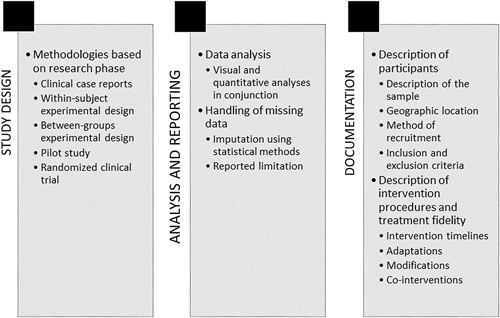
Checklist for future studies.
Study Design
Although randomized controlled trials are the gold standard in intervention research, they may not be feasible for the early evaluation of interventions. Other study designs such as clinical case reports, within-subjects and between-groups experimental studies, and pilot studies may provide a good balance between investigative rigor and practicality (Skolasky, 2016; Smith et al, 2007).
Data Analysis and Reporting of Results
There are several ways in which future studies of interventions for adults with ASD–3 could minimize issues relating to the analysis and reporting of results. First, it would be helpful if studies used both visual and quantitative analyses to gain the most accurate inferences from the data and to allow for broader conclusions to be made across studies (Skolasky, 2016).
Second, future studies should attempt to be more rigorous in their handling of missing data. Relevant to this, the ASD–3 population presents a number of logistical challenges, including, but not limited to, issues related to transportation, which increase the likelihood of missing data. However, it is important that future studies make careful attempts to minimize missing data and address whatever issues arise using rigorous statistical methods (Skolasky, 2016). At the very least, missing data are a limitation that should be acknowledged. We are optimistic that future initiatives will more effectively reduce the impact of missing data, as widely used statistical packages such as R (R Core Team, 2018) allow researchers with no statistical background to effectively analyze challenging data sets, including those involving small sample sizes and case studies with missing data (Skolasky, 2016).
Third, although interventions may not show a significant effect size, they may still lead to meaningful behavior change. Thus, future studies should include mixed quantitative and qualitative methodologies so that any clinical impact (even if not statistically significant) may be comprehensively reported.
Documentation of Methodologies and Procedures
It would be helpful if researchers documented detailed methodologies so as to allow other groups to replicate the results and translate the findings to clinical practice. First, it would serve the field well to standardize how participants are described. Many inconsistencies in reporting, to date, may be attributable to journals’ adherences to different style manuals: for example, the American Medical Association (2007) requires that authors state how many participants were selected and how many did not agree to participate, whereas the American Psychological Association (2010) does not have this requirement. Going forward, it would help to address inconsistencies in reporting if journals were to implement reporting standards like those set forth in the PRISMA (Preferred Reporting Items for Systematic Reviews and Meta-Analyses) statement (Liberati et al, 2009) and the Cochrane template (Higgins and Green, 2011); this could include a description of the sample, geographic location, setting, method of recruitment, and detailed inclusion and exclusion criteria.
Second, future studies should attempt to be more thorough in reporting their intervention procedures so that researchers and clinicians alike can make use of their findings. Studies should also provide assurances of treatment fidelity and coding reliability to ensure that interventions are delivered and measured as intended. Specifically, a full description of intervention time lines (ie, intensity and duration of treatment), adaptations, and modifications should be provided along with reporting of relevant co-interventions.
Limitations of This Review
Our literature search process had limitations. First, our English-language requirement clearly biased our search toward Western populations and Western investigators. In the future, electronic translation should enable access to scientific literature from different countries.
Second, our heavy reliance on an electronic search was also a key limitation. Despite using what we considered were broad search terms, the electronic search failed to identify 10 studies that we identified as relevant in our manual search. This limitation of the electronic search probably has several bases, including the challenges of using an electronic search for materials that were produced before the electronic publishing era, the inconsistency in the type of information available in digital form, and the coding of potentially relevant studies. Because coding and tagging inevitably cannot capture all variables that may be of interest, we anticipate that the increasing use of full-text searches using synonyms may help address this pitfall.
Third, we required the literature to be peer reviewed. Although peer review helps ensure scientific rigor, it is hardly a guarantee of quality. We suspect there may be studies that could contribute to our knowledge of interventions for this population that were not peer reviewed, and therefore were not taken into consideration. We suspect a fundamental problem could be that many of the efforts into this field of research have not been documented. We are personally aware of several clinicians and educators who are designing and implementing interventions that seem to be successful, but, for various reasons, have not been documented or published. For these and other reasons, we believe this current review necessarily underestimates the achievements made in the field as a whole.
CONCLUSION
Although we found moderately reliable evidence to support the effectiveness of interventions designed to improve emotional functioning in adults with ASD–3, in general, the available literature on psychoeducational interventions for adults with ASD–3 was extremely limited and presented significant methodological limitations. Given the poor prognosis for adults with ASD–3, it is vitally important to continue to design and test targeted, scalable interventions for this often-overlooked clinical population. As we continue to improve methodological standards leading to the standardized practice of full and accurate reporting, we are optimistic that there will be more evidence-based interventions to help improve the lives of individuals with ASD–3.
ACKNOWLEDGMENTS
The authors thank Alan Gerber, PhD, Jeff Sigafoos, PhD, Kara Hume, PhD, Devender Banda, PhD, Carly Gilson, PhD, and Shari McKee, PhD, who responded to our requests for additional information. The authors also thank the faculty and staff of the Johns Hopkins School of Medicine, Department of Neurology’s, Division of Cognitive Neurology/Neuropsychology and the Division’s New York Educational Program. The authors particularly thank Nancy Grund, Cristiana Camardella, LaQuata Pascarell, Damaris Frias, Olivia Pullara, Kathleen Keller, and Jessica O’Grady for their support of this project.
Footnotes
Associate Editor Victor W. Henderson oversaw the review process for this article.
Supported in part by the Therapeutic Cognitive Neurology Fund, with additional support from the Therapeutic Cognitive Neuroscience Professorship, Johns Hopkins University; the Benjamin and Adith Miller Family Endowment for Aging, Alzheimer’s, and Autism; the Binder Family Charitable Fund; the Murren Family Foundation; the Wockenfuss Endowment and Fund; and anonymous donors.
The authors declare no conflicts of interest.
REFERENCES
- Adelinis JD, Hagopian LP. 1999. The use of symmetrical “do” and “don’t” requests to interrupt ongoing activities. J Appl Behav Anal. 32:519–523. doi:10.1901/jaba.1999.32-519 [DOI] [PMC free article] [PubMed] [Google Scholar]
- American Medical Association. 2007. AMA Manual of Style: A Guide for Authors and Editors, 10th ed New York, New York: Oxford University Press. [Google Scholar]
- American Psychiatric Association. 2013. Diagnostic and Statistical Manual of Mental Disorders, 5th ed Washington, DC: American Psychiatric Association. [Google Scholar]
- American Psychological Association. 2010. Publication Manual of the American Psychological Association, 6th ed Washington, DC: American Psychological Association. [Google Scholar]
- Aylott J. 2000. Autism in adulthood: the concepts of identity and difference. Br J Nurs. 9:851–858. doi:10.12968/bjon.2000.9.13.5513 [DOI] [PubMed] [Google Scholar]
- Baer DM, Wolf MM, Risley TR. 1968. Some current dimensions of applied behavior analysis. J Appl Behav Anal. 1:91–97. doi:10.1901/jaba.1968.1-91 [DOI] [PMC free article] [PubMed] [Google Scholar]
- Baker DJ, Valenzuela S, Wieseler NA. 2005. Naturalistic inquiry and treatment of coprophagia in one individual. J Dev Phys Disabil. 17:361–367. doi:10.1007/s10882-005-6619-2 [Google Scholar]
- Banda DR, Copple KS, Koul RK, et al. 2010. Video modelling interventions to teach spontaneous requesting using AAC devices to individuals with autism: a preliminary investigation. Disabil Rehabil. 32:1364–1372. [DOI] [PubMed] [Google Scholar]
- Bebko JM, Perry A, Bryson S. 1996. Multiple method validation study of facilitated communication: II. Individual differences and subgroup results. J Autism Dev Disord. 26:19–42. doi:10.1007/BF02276233 [DOI] [PubMed] [Google Scholar]
- Bennett K, Brady MP, Scott J, et al. 2010. The effects of covert audio coaching on the job performance of supported employees. Focus Autism Other Dev Disabil. 25:173–185. doi:10.1177/1088357610371636 [Google Scholar]
- Bishop-Fitzpatrick L, Minshew NJ, Eack SM.Volkmar F, Reichow B, McPartland J. 2013. A systematic review of psychosocial interventions for adults with autism spectrum disorders. Adolescents and Adults With Autism Spectrum Disorders. New York, New York: Springer; 687–694. doi:10.1007/978-1-4939-0506-5_16 [DOI] [PMC free article] [PubMed] [Google Scholar]
- Boso M, Emanuele E, Minazzi V, et al. 2007. Effect of long-term interactive music therapy on behavior profile and musical skills in young adults with severe autism. J Altern Complement Med. 13:709–712. doi:10.1089/acm.2006.6334 [DOI] [PubMed] [Google Scholar]
- Breen C, Haring T, Pitts-Conway V, et al. 1985. The training and generalization of social interaction during breaktime at two job sites in the natural environment. J Assoc Pers Sev Handicaps. 10:41–50. doi:10.1177/154079698501000105 [Google Scholar]
- Broadstock M, Doughty C, Eggleston M. 2007. Systematic review of the effectiveness of pharmacological treatments for adolescents and adults with autism spectrum disorder. Autism. 11:335–348. doi:10.1177/1362361307078132 [DOI] [PubMed] [Google Scholar]
- Brugha TS, Doos L, Tempier A, et al. 2015. Outcome measures in intervention trials for adults with autism spectrum disorders; a systematic review of assessments of core autism features and associated emotional and behavioural problems. Int J Methods Psychiatr Res. 24:99–115. doi:10.1002/mpr.1466 [DOI] [PMC free article] [PubMed] [Google Scholar]
- Campillo C, Herrera G, Ganuza R, et al. 2014. Using Tic-Tac software to reduce anxiety-related behaviour in adults with autism and learning difficulties during waiting periods: a pilot study. Autism. 18:264–271. doi:10.1177/1362361312472067 [DOI] [PubMed] [Google Scholar]
- Carminati GG, Gerber F, Baud MA, et al. 2007. Evaluating the effects of a structured program for adults with autism spectrum disorders and intellectual disabilities. Res Autism Spectr Disord. 1:256–265. doi:10.1016/j.rasd.2006.11.001 [Google Scholar]
- Carr EG, Yarbrough SC, Langdon NA. 1997. Effects of idiosyncratic stimulus variables on functional analysis outcomes. J Appl Behav Anal. 30:673–686. doi:10.1901/jaba.1997.30-673 [DOI] [PMC free article] [PubMed] [Google Scholar]
- Cividini-Motta C, Ahearn WH. 2013. Effects of two variations of differential reinforcement on prompt dependency. J Appl Behav Anal. 46:640–650. doi:10.1002/jaba.67 [DOI] [PubMed] [Google Scholar]
- Committee on Children With Disabilities 1998. Auditory integration training and facilitated communication for autism. Pediatrics. 102:431–433. doi:10.1542/peds.102.2.431 [PubMed] [Google Scholar]
- DeJong H, Bunton P, Hare DJ. 2014. A systematic review of interventions used to treat catatonic symptoms in people with autistic spectrum disorders. J Autism Dev Disord. 44:2127–2136. doi:10.1007/s10803-0142085-y [DOI] [PubMed] [Google Scholar]
- Duker PC, Schaapveld M. 1996. Increasing on-task behaviour through interruption prompting. J Intellect Disabil Res. 40:291–297. doi:10.1046/j.1365-2788.1996.775775.x [DOI] [PubMed] [Google Scholar]
- Edrisinha C, O’Reilly MF, Choi HY, et al. 2011. “Say cheese”: teaching photography skills to adults with developmental disabilities. Res Dev Disabil. 32:636–642. [DOI] [PubMed] [Google Scholar]
- El Achkar CM, Spence SJ. 2015. Clinical characteristics of children and young adults with co-occurring autism spectrum disorder and epilepsy. Epilepsy Behav. 47:183–190. doi:10.1016/j.yebeh.2014.12.022 [DOI] [PubMed] [Google Scholar]
- Elliott RO, Dobbin AR, Rose GD, et al. 1994. Vigorous, aerobic exercise versus general motor training activities: effects on maladaptive and stereotypic behaviors of adults with both autism and mental retardation. J Autism Child Schizophr. 24:565–576. doi:10.1007/BF02172138 [DOI] [PubMed] [Google Scholar]
- Elliott RO, Hall K, Soper HV. 1991. Analog language teaching versus natural language teaching: generalization and retention of language learning for adults with autism and mental retardation. J Autism Child Schizophr. 21:433–447. doi:10.1007/BF02206869 [DOI] [PubMed] [Google Scholar]
- Fava L, Strauss K. 2010. Multi-sensory rooms: comparing effects of the Snoezelen and the Stimulus Preference environment on the behavior of adults with profound mental retardation. Res Dev Disabil. 31:160–171. doi:10.1016/j.ridd.2009.08.006 [DOI] [PubMed] [Google Scholar]
- García-Villamisar DA, Dattilo J. 2010. Effects of a leisure programme on quality of life and stress of individuals with ASD. J Intellect Disabil Res. 54:611–619. doi:10.1111/j.1365-2788.2010.01289.x [DOI] [PubMed] [Google Scholar]
- Gates JA, Kang E, Lerner MD. 2017. Efficacy of group social skills interventions for youth with autism spectrum disorder: a systematic review and meta-analysis. Clin Psychol Rev. 52:164–181. doi:10.1016/j.cpr.2017.01.006 [DOI] [PMC free article] [PubMed] [Google Scholar]
- Gaylord-Ross RJ, Haring TG, Breen C, et al. 1984. The training and generalization of social interaction skills with autistic youth. J Appl Behav Anal. 17:229–247. doi:10.1901/jaba.1984.17-229 [DOI] [PMC free article] [PubMed] [Google Scholar]
- Gerber AH, McCormick CEB, Levine TP, et al. 2017. Brief report: factors influencing healthcare satisfaction in adults with autism spectrum disorder. J Autism Child Schizophr. 47:1896–1903. doi:10.1007/s10803-017-3087-3 [DOI] [PubMed] [Google Scholar]
- Gerber F, Bessero S, Robbiani B, et al. 2011. Comparing residential programmes for adults with autism spectrum disorders and intellectual disability: outcomes of challenging behaviour and quality of life. J Intellect Disabil Res. 55:918–932. doi:10.1111/j.1365-2788.2011.01455.x [DOI] [PubMed] [Google Scholar]
- Gilson CB, Carter EW. 2016. Promoting social interactions and job independence for college students with autism or intellectual disability: a pilot study. J Autism Dev Disord. 46:3583–3596. doi:10.1007/s10803-016-2894-2 [DOI] [PubMed] [Google Scholar]
- Goodson J, Sigafoos J, O’Reilly M, et al. 2007. Evaluation of a video-based error correction procedure for teaching a domestic skill to individuals with developmental disabilities. Res Dev Disabil. 28:458–467. doi:10.1016/j.ridd.2006.06.002 [DOI] [PubMed] [Google Scholar]
- Graff RB, Gibson L. 2003. Using pictures to assess reinforcers in individuals with developmental disabilities. Behav Modif. 27:470–483. doi:10.1177/0145445503255602 [DOI] [PubMed] [Google Scholar]
- Gutstein S. 2009. Empowering families through relationship development intervention: an important part of the biopsychosocial management of autism spectrum disorders. Ann Clin Psychiatry. 21:174–182. [PubMed] [Google Scholar]
- Hagopian LP, González ML, Rivet TT, et al. 2011. Response interruption and differential reinforcement of alternative behavior for the treatment of pica. Behav Interv. 26:309–325. doi:10.1002/bin.339 [Google Scholar]
- Hanley GP, Iwata BA, Thompson RH, et al. 2000. A component analysis of “stereotypy as reinforcement” for alternative behavior. J Appl Behav Anal. 33:285–297. doi:10.1901/jaba.2000.33-285 [DOI] [PMC free article] [PubMed] [Google Scholar]
- Haring TG, Kennedy CH, Adams MJ, et al. 1987. Teaching generalization of purchasing skills across community settings to autistic youth using videotape modeling. J Appl Behav Anal. 20:89–96. doi:10.1901/jaba.1987.20-89 [DOI] [PMC free article] [PubMed] [Google Scholar]
- Heflin JL, Simpson RL. 1998. Interventions for children and youth with autism: prudent choices in a world of exaggerated claims and empty promises. Part I: Interventionand treatment option review. Focus Autism Other Dev Disabil. 13:194–211. doi:10.1177/108835769801300401 [Google Scholar]
- Higgins JPT, Green S. 2011. Cochrane Handbook for Systematic Reviews of Interventions. Version 5.1 West Sussex, England: John Wiley & Sons. The Cochrane Collaboration. [Google Scholar]
- Howard-Jones PA. 2014. Neuroscience and education: myths and messages. Nat Rev Neurosci. 15:817–824. [DOI] [PubMed] [Google Scholar]
- Hume K, Odom S. 2007. Effects of an individual work system on the independent functioning of students with autism. J Autism Dev Disord. 37:1166–1180. doi:10.1007/s10803-006-0260-5 [DOI] [PubMed] [Google Scholar]
- Individuals with Disabilities Education Act. 2004 20 U.S.C. § 1400. [Google Scholar]
- Jerome J, Frantino EP, Sturmey P. 2007. The effects of errorless learning and backward chaining on the acquisition of internet skills in adults with developmental disabilities. J Appl Behav Anal. 40:185–189. doi:10.1901/jaba.2007.41-06 [DOI] [PMC free article] [PubMed] [Google Scholar]
- Kaplan H, Clopton M, Kaplan M, et al. 2006. Snoezelen multi-sensory environments: task engagement and generalization. Res Dev Disabil. 27:443–455. doi:10.1016/j.ridd.2005.05.007 [DOI] [PubMed] [Google Scholar]
- Kasari C, Shire S, Factor R, et al. 2014. Psychosocial treatments for individuals with autism spectrum disorder across the lifespan: new developments and underlying mechanisms. Curr Psychiatry Rep. 16:512–523. doi:10.1007/s11920-014-0512-6 [DOI] [PubMed] [Google Scholar]
- Kennedy CH. 1994. Manipulating antecedent conditions to alter the stimulus control of problem behavior. J Appl Behav Anal. 27:161–170. doi:10.1901/jaba.1994.27-161 [DOI] [PMC free article] [PubMed] [Google Scholar]
- Koegel LK, Koegel RL, Harrower JK, et al. 1999. Pivotal response intervention I: overview of approach. J Assoc Pers Sev Handicaps. 24:174–185. doi:10.2511/rpsd.24.3.174 [Google Scholar]
- Kuhn DE, DeLeon IG, Fisher WW, et al. 1999. Clarifying an ambiguous functional analysis with matched and mismatched extinction procedures. J Appl Behav Anal. 32:99–102. doi:10.1901/jaba.1999.32-99 [DOI] [PMC free article] [PubMed] [Google Scholar]
- Lai MC, Lombardo MV, Auyeung B, et al. 2015. Sex/gender differences and autism: setting the scene for future research. J Am Acad Child Adolesc Psychiatry. 54:11–24. doi:10.1016/j.jaac.2014.10.003 [DOI] [PMC free article] [PubMed] [Google Scholar]
- Lattimore LP, Parsons MB, Reid DH. 2008. Simulation training of community job skills for adults with autism: a further analysis. Behav Anal Pract. 1:24–29. doi:10.1007/BF03391717 [DOI] [PMC free article] [PubMed] [Google Scholar]
- Lattimore LP, Parsons MB, Reid DH. 2009. Rapid training of a community job skill to nonvocal adults with autism: an extension of intensive teaching. Behav Anal Pract. 2:34–42. doi:10.1007/BF03391735 [DOI] [PMC free article] [PubMed] [Google Scholar]
- Lee R, McComas JJ, Jawor J. 2002. The effects of differential and lag reinforcement schedules on varied verbal responding by individuals with autism. J Appl Behav Anal. 35:391–402. doi:10.1901/jaba.2002.35-391 [DOI] [PMC free article] [PubMed] [Google Scholar]
- Leigh JP, Du J. 2015. Brief report: forecasting the economic burden of autism in 2015 and 2025 in the United States. J Autism Child Schizophr. 45:4135–4139. [DOI] [PubMed] [Google Scholar]
- Liberati A, Altman DG, Tetzlaff J, et al. 2009. The PRISMA statement for reporting systematic reviews and meta-analyses of studies that evaluate healthcare interventions: explanation and elaboration. BMJ. 339:b2700 doi:10.1136/bmj.b2700 [DOI] [PMC free article] [PubMed] [Google Scholar]
- Lips HM. 2017. Sex and Gender: An Introduction, 6th ed New York, New York: Waveland Press. [Google Scholar]
- Liu KPY, Wong D, Chung ACY, et al. 2013. Effectiveness of a workplace training programme in improving social, communication and emotional skills for adults with autism and intellectual disability in Hong Kong—a pilot study. Occup Ther Int. 20:198–204. doi:10.1002/oti.1356 [DOI] [PubMed] [Google Scholar]
- Lorenc T, Rodgers M, Marshall D, et al. 2018. Support for adults with autism spectrum disorder without intellectual impairment: systematic review. Autism. 22:654–668. doi:10.1177/1362361317698939 [DOI] [PubMed] [Google Scholar]
- Lundqvist L-O, Andersson G, Viding J. 2009. Effects of vibroacoustic music on challenging behaviors in individuals with autism and developmental disabilities. Res Autism Spectr Disord. 3:390–400. doi:10.1016/j.rasd.2008.08.005 [Google Scholar]
- Matson JL. 1996. Behavioral treatment of autistic persons: a review of research from 1980 to the present. Res Dev Disabil. 17:433–465. doi:10.1016/s0891-4222(96)00030-3 [DOI] [PubMed] [Google Scholar]
- Matson JL, Cervantes PE, Peters WJ. 2016. Autism spectrum disorders: management over the lifespan. Expert Rev Neurother. 16:1301–1310. doi:10.1080/14737175.2016.1203255 [DOI] [PubMed] [Google Scholar]
- Matson JL, Sipes M, Fodstad JC, et al. 2011. Issues in the management of challenging behaviours of adults with autism spectrum disorder. CNS Drugs. 25:597–606. doi:10.2165/11591700-000000000-00000 [DOI] [PubMed] [Google Scholar]
- McClean B, Grey IM, McCracken M. 2007. An evaluation of positive behavioural support for people with very severe challenging behaviours in community-based settings. J Intellect Disabil Res. 11:281–301. doi:10.1177/1744629507080791 [DOI] [PubMed] [Google Scholar]
- McKee SA, Harris GT, Rice ME, et al. 2007. Effects of a Snoezelen room on the behavior of three autistic clients. Res Dev Disabil. 28:304–316. doi:10.1016/j.ridd.2006.04.001 [DOI] [PubMed] [Google Scholar]
- McKeegan G, Estill K, Campbell BM. 1984. Use of nonexclusionary timeout for the elimination of a stereotyped behavior. J Behav Ther Exp Psychiatry. 15:261–264. [DOI] [PubMed] [Google Scholar]
- McKeegan G, Estill K, Campbell BM. 1987. Elimination of rumination by controlled eating and differential reinforcement. J Behav Ther Exp Psychiatry. 18:143–148. [DOI] [PubMed] [Google Scholar]
- McNally RJ, Calamari JE, Hansen PM, et al. 1988. Behavioral treatment of psychogenic polydipsia. J Behav Ther Exp Psychiatry. 19:57–61. doi:10.1016/0005-7916(88)90011-0 [DOI] [PubMed] [Google Scholar]
- Millar DC, Light JC, Schlosser RW. 2006. The impact of augmentative and alternative communication intervention on the speech production of individuals with developmental disabilities: a research review. J Speech Hear Res. 49:248–264. doi:10.1044/1092-4388(2006/021) [DOI] [PubMed] [Google Scholar]
- Moore TR. 2009. A brief report on the effects of a self-management treatment package on stereotypic behavior. Res Autism Spect Dis. 3:695–701. doi:10.1016/j.rasd.2009.01.010 [Google Scholar]
- Nicholas DB, Attridge M, Zwaigenbaum L, et al. 2015. Vocational support approaches in autism spectrum disorder: a synthesis review of the literature. Autism. 19:235–245. doi:10.1177/1362361313516548 [DOI] [PubMed] [Google Scholar]
- Olive ML, Smith BW. 2005. Effect size calculations and single subject designs. Educ Psychol-UK. 25:313–324. doi:10.1080/0144341042000301238 [Google Scholar]
- R Core Team. 2018. R: A Language and Environment for Statistical Computing [Computer Software]. Vienna, Austria: R Foundation for Statistical Computing. [Google Scholar]
- Ratto AB, Mesibov GB. 2015. Autism spectrum disorders in adolescence and adulthood: long-term outcomes and relevant issues for treatment and research. Sci China Life Sci. 58:1010–1015. doi:10.1007/s11427-012-4295-x [DOI] [PubMed] [Google Scholar]
- Reese RM, Sherman JA, Sheldon JB. 1998. Reducing disruptive behavior of a group-home resident with autism and mental retardation. J Autism Child Schizophr. 28:159–165. doi:10.1023/A:1026096700607 [DOI] [PubMed] [Google Scholar]
- Rehfeldt RA, Chambers MR. 2003. Functional analysis and treatment of verbal perseverations displayed by an adult with autism. J Appl Behav Anal. 36:259–261. doi:10.1901/jaba.2003.36-259 [DOI] [PMC free article] [PubMed] [Google Scholar]
- Reichow B, Barton EE, Maggin DM. 2018. Development and applications of the single-case design risk of bias tool for evaluating single-case design research study reports. Res Dev Disabil. 79:53–64. doi:10.1016/j.ridd.2018.05.008 [DOI] [PubMed] [Google Scholar]
- Reichow B, Steiner AM, Volkmar F. 2013. Cochrane review: social skills groups for people aged 6 to 21 with autism spectrum disorders (ASD). Evid Based Child Health. 8:266–315. doi:10.1002/ebch.1903 [DOI] [PubMed] [Google Scholar]
- Reichow B, Volkmar FR. 2010. Social skills interventions for individuals with autism: evaluation for evidence-based practices within a best evidence synthesis framework. J Autism Dev Disord. 40:149–166. doi:10.1007/s10803-009-0842-0 [DOI] [PubMed] [Google Scholar]
- Rutter M. 1996. Autism research: prospects and priorities. J Autism Dev Disord. 26:257–275. doi:10.1007/BF02172023 [DOI] [PubMed] [Google Scholar]
- Saiano M, Pellegrino L, Casadio M, et al. 2015. Natural interfaces and virtual environments for the acquisition of street crossing and path following skills in adults with autism spectrum disorders: a feasibility study. J Neuroeng Rehabil. 12:17 doi:10.1186/s12984-015-0010-z [DOI] [PMC free article] [PubMed] [Google Scholar]
- Schreibman L. 1996. Brief report: the case for social and behavioral intervention research. J Autism Child Schizophr. 26:247–250. [DOI] [PubMed] [Google Scholar]
- Schünemann H, Brożek J, Guyatt G, et al., editors. 2013. Handbook for Grading the Quality of Evidence and the Strength of Recommendations Using the GRADE Approach. Available at: gdt.guidelinedevelopment.org/app/handbook/handbook.html. Accessed January 2019.
- Shabani DB, Fisher WW. 2006. Stimulus fading and differential reinforcement for the treatment of needle phobia in a youth with autism. J Appl Behav Anal. 39:449–452. doi:10.1901/jaba.2006.30-05 [DOI] [PMC free article] [PubMed] [Google Scholar]
- Shattuck PT, Roux AM, Hudson LE, et al. 2012. Services for adults with an autism spectrum disorder. Can J Psychiatry. 57:284–291. doi:10.1177/070674371205700503 [DOI] [PMC free article] [PubMed] [Google Scholar]
- Sheehan CM, Matuozzi RT. 1996. Investigation of the validity of facilitated communication through the disclosure of unknown information. Ment Retard. 34:94–107. [PubMed] [Google Scholar]
- Sheridan K, Raffield T.Matson JL. 2008. Teaching adaptive skills to people with autism. Clinical Assessment and Intervention for Autism Spectrum Disorders. San Diego, California: Academic Press; 327–350. doi:10.1016/B978-012373606-2.50013-9 [Google Scholar]
- Siaperas P, Beadle-Brown J. 2006. A case study of the use of a structured teaching approach in adults with autism in a residential home in Greece. Autism. 10:330–343. doi:10.1177/1362361306064433 [DOI] [PubMed] [Google Scholar]
- Sigafoos J, Drasgow E, Halle JW, et al. 2004a. Teaching VOCA use as a communicative repair strategy. J Autism Child Schizophr. 34:411–422. doi:10.1023/B:JADD.0000037417.04356.9c [DOI] [PubMed] [Google Scholar]
- Sigafoos J, O’Reilly M, Seely-York S, et al. 2004b. Teaching students with developmental disabilities to locate their AAC device. Res Dev Disabil. 25:371–383. doi:10.1016/j.ridd.2003.07.002 [DOI] [PubMed] [Google Scholar]
- Singh JS, Bunyak G. 2019. Autism disparities: a systematic review and meta-ethnography of qualitative research. Qual Health Res. 29:796–808. doi:10.1177/1049732318808245 [DOI] [PubMed] [Google Scholar]
- Sinha Y, Silove N, Wheeler D, et al. 2006. Auditory integration training and other sound therapies for autism spectrum disorders: a systematic review. Arch Dis Child. 91:1018–1022. doi:10.1136/adc.2006.094649 [DOI] [PMC free article] [PubMed] [Google Scholar]
- Sinha Y, Silove N, Williams K, et al. 2004. Auditory integration training and other sound therapies for autism spectrum disorders. Cochrane Database Syst Rev. doi:10.1002/14651858.CD003681.pub2 [DOI] [PubMed] [Google Scholar]
- Skinner BF. 1957. Verbal Behavior. New York, New York: Appleton-Century-Crofts. [Google Scholar]
- Skolasky RLJ. 2016. Considerations in writing about single-case experimental design studies. Cogn Behav Neurol. 29:169–173. doi:10.1097/WNN.0000000000000112 [DOI] [PubMed] [Google Scholar]
- Smith MD. 1986. Use of similar sensory stimuli in the community-based treatment of self-stimulatory behavior in an adult disabled by autism. J Behav Ther Exp Psychiatry. 17:121–125. [DOI] [PubMed] [Google Scholar]
- Smith MD. 1987. Treatment of pica in an adult disabled by autism by differential reinforcement of incompatible behavior. J Behav Ther Exp Psychiatry. 18:285–288. [DOI] [PubMed] [Google Scholar]
- Smith MD, Belcher R. 1985. Teaching life skills to adults disabled by autism. J Autism Child Schizophr. 15:163–175. doi:10.1007/BF01531602 [DOI] [PubMed] [Google Scholar]
- Smith MD, Coleman D. 1986. Managing the behavior of adults with autism in the job setting. J Autism Child Schizophr. 16:145–154. doi:10.1007/BF01531726 [DOI] [PubMed] [Google Scholar]
- Smith T, Scahill L, Dawson G, et al. 2007. Designing research studies on psychosocial interventions in autism. J Autism Child Schizophr. 37:354–366. doi:10.1007/s10803-006-0173-3 [DOI] [PubMed] [Google Scholar]
- Solomon R, Necheles J, Ferch C, et al. 2007. Pilot study of a parent training program for young children with autism: the PLAY project home consultation program. Autism. 11:205–224. doi:10.1177/1362361307076842 [DOI] [PubMed] [Google Scholar]
- Sterne JA, Hernán MA, Reeves BC, et al. 2016. ROBINS-I: a tool for assessing risk of bias in non-randomised studies of interventions. BMJ. 355:i4919 doi:10.1136/bmj.i4919 [DOI] [PMC free article] [PubMed] [Google Scholar]
- Stoner JB, Beck AR, Bock SJ, et al. 2006. The effectiveness of the picture exchange communication system with nonspeaking adults. Remedial Spec Educ. 27:154–165. doi:10.1177/07419325060270030401 [Google Scholar]
- Sturmey P. 2012. Treatment of psychopathology in people with intellectual and other disabilities. Can J Psychiatry. 57:593–600. doi:10.1177/070674371205701003 [DOI] [PubMed] [Google Scholar]
- Taylor JL, McPheeters ML, Sathe NA, et al. 2012. A systematic review of vocational interventions for young adults with autism spectrum disorders. Pediatrics. 130:531–538. doi:10.1542/peds.2012-0682 [DOI] [PMC free article] [PubMed] [Google Scholar]
- Tsai LY. 1999. Psychopharmacology in Autism. Psychosom Med. 61:651–665. [DOI] [PubMed] [Google Scholar]
- Van Bourgondien ME, Reichle NC, Schopler E. 2003. Effects of a model treatment approach on adults with autism. J Autism Child Schizophr. 33:131–140. doi:10.1023/A:1022931224934 [DOI] [PubMed] [Google Scholar]
- Vismara LA, Rogers SJ. 2010. Behavioral treatments in autism spectrum disorder: what do we know? Annu Rev Clin Psychol. 6:447–468. doi:10.1146/annurev.clinpsy.121208.131151 [DOI] [PubMed] [Google Scholar]
- Volkmar F, Cook E, Pomeroy J, et al. 1999. Summary of the practice parameters for the assessment and treatment of children, adolescents, and adults with autism and other pervasive developmental disorders. J Am Acad Child Adolesc Psychiatry. 38(suppl):32S–54S. [DOI] [PubMed] [Google Scholar]
- Volkmar F, Reichow B, McPartland JC.Volkmar F, Reichow B, McPartland JC. 2014. Autism spectrum disorder in adolescents and adults: an introduction. Adolescents and Adults With Autism Spectrum Disorders. New York, New York: Springer; 1–13. doi:10.1007/978-1-4939-0506-5_1 [Google Scholar]
- Vuran S. 2008. Empowering leisure skills in adults with autism: an experimental investigation through the most to least prompting procedure. Int J Spec Educ. 23:174–181. [Google Scholar]
- Walton KM, Ingersoll BR. 2013. Improving social skills in adolescents and adults with autism and severe to profound intellectual disability: a review of the literature. J Autism Child Schizophr. 43:594–615. doi:10.1007/s10803-012-1601-1 [DOI] [PubMed] [Google Scholar]
- Weiss MJ, Harris SL. 2001. Teaching social skills to people with autism. Behavior Modification. 25:785–802. doi:10.1177/0145445501255007 [DOI] [PubMed] [Google Scholar]
- Wong C, Odom SL, Hume KA, et al. 2015. Evidence-based practices for children, youth, and young adults with autism spectrum disorder: a comprehensive review. J Autism Child Schizophr. 45:1951–1966. doi:10.1007/s10803-014-2351-z [DOI] [PubMed] [Google Scholar]
- Wong SE, Floyd J, Innocent A, et al. 1991. Applying a DRO schedule and compliance training to reduce aggressive and self-injurious behavior in an autistic man: a case report. J Behav Ther Exp Psychiatry. 22:299–304. doi:10.1016/0005-7916(91)90048-A [DOI] [PubMed] [Google Scholar]
- Young J, Corea C, Kimani J, et al. 2010. Autism Spectrum Disorders (ASDs) Services: Final Report on Environmental Scan. Columbia, Maryland: IMPAQ International. [Google Scholar]



